acf domain was triggered too early. This is usually an indicator for some code in the plugin or theme running too early. Translations should be loaded at the init action or later. Please see Debugging in WordPress for more information. (This message was added in version 6.7.0.) in /home/philipf84/mydesignjournal.ie/wp-includes/functions.php on line 6121
The information in this section supports Brief 1 of
My Architecture Design Journal and gives you an
introduction to some aspects of architecture
before you begin your own design project.
We hope it inspires you!
This selection of pioneers and visionaries can help you to gain an overview of key figures and diverse styles in architecture.
Use these profiles to help with your online research.
Frank Lloyd Wright
1867 – 1959
Nationality: American
Design aesthetic: Architect, interior designer, writer and educator, Wright designed structures which were in harmony with humanity and its environment, a philosophy he called organic architecture.
Building types: Offices, churches, schools, skyscrapers, hotels, and museums and building interiors.
Known for: Robie House, Price Tower, Fallingwater, Johnson Wax Headquarters, Solomon R. Guggenheim Museum, Taliesin and Darwin D. Martin House

Le Corbusier
1887 –1965
Nationality: Swiss/French
Design aesthetic: Architect, designer, urbanist, and writer, Corbusier’s designs were modern high design and were dedicated to providing better living conditions for the residents of crowded cities.
Building types: Residential Complexes, Museums, Pavilions, residential homes, church
Known for: Villa Savoye, France; Notre Dame du Haut, France; Buildings in Chandigarh, India
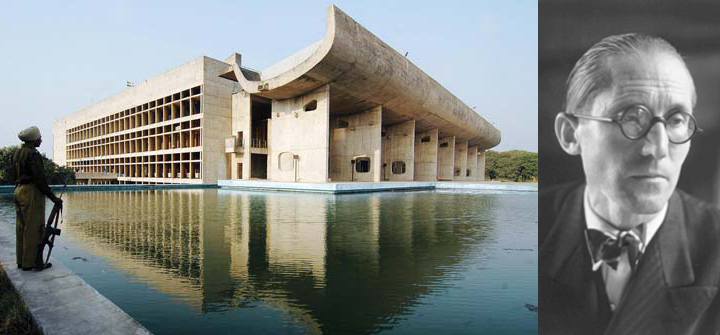
Eileen Gray
1878 – 1976
Nationality: Irish
Design aesthetic: Architect, interior and furniture designer, Grey pursued the alliance of form and function in an expressive modern spirit.
Building types: Architecture, Furniture and Interior Design
Known for: E-1027, (a unique house in South of France)The ‘Tempe à Pailla’ House ,the Bibendum Chair and her lacquer work

Ludwig Mies van der Rohe
1886 – 1969
Nationality: German-American
Design aesthetic: Architect and educator, Mies van der Rohe developed and built his vision of a monumental “skin and bones” architecture that reflected his goal to provide the individual a place to fulfill himself in the modern era. Mies sought to create free and open spaces, enclosed within a structural order with minimal presence.
Building types: Residential apartment complexes, residential homes, offices, university complexes and pavilions.
Known for: Barcelona Pavilion, Tugendhat House, Crown Hall, Farnsworth House, 860–880 Lake Shore Drive, Seagram Building, New National Gallery, Berlin, Toronto-Dominion Centre,
Westmount Square
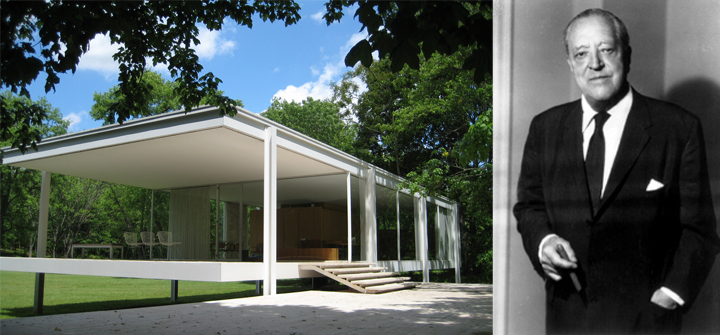
Walter Gropius
1883 – 1969
Nationality: German/American
Design aesthetic: Architect, author and educator had a functionalist approach to design.
Building types: Office, factory, residential homes, hospital, college faulty, school, large-scale housing projects.
Known for: Fagus Factory, Werkbund Exhibition (1914), Bauhaus, Gropius House, University of Baghdad, J.F. Kennedy Federal Building and Pan Am Building
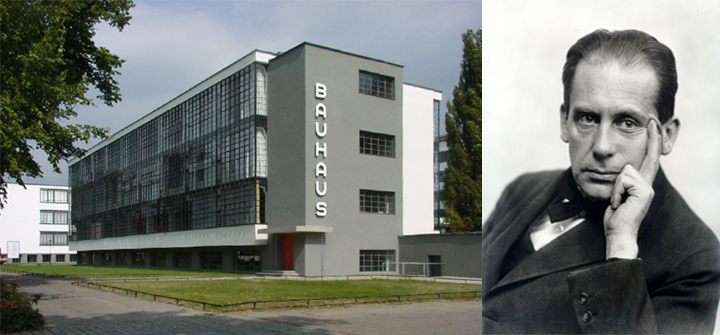
Oscar Niemeyer
1907 – 2012
Nationality: Brazilian
Design aesthetic: Architect who is considered to be one of the key figures in the development of modern architecture.
Building types: Hospital, College, Headquarters, residential homes, town planning and landscaping
Known for: Palácio da Alvorada, Cathedral of Brasília, National Congress of Brazil, Edifício Copan, Ibirapuera Park, United Nations headquarters, Niterói Contemporary Art Museum, Latin America Memorial and Gustavo Capanema Palace
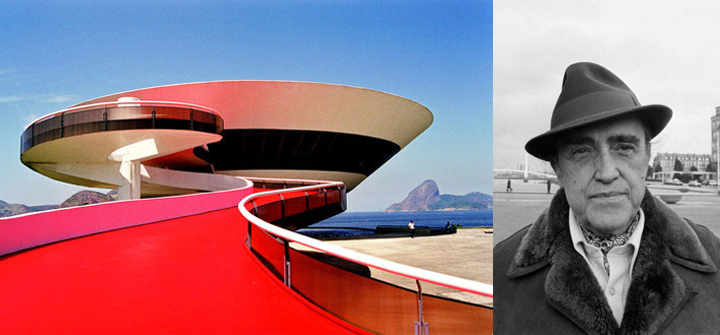
Renzo Piano
born 1937
Nationality: Italian
Design aesthetic: Architecture critic Nicolai Ouroussoff said of Piano’s works that the “…serenity of his best buildings can almost make you believe that we live in a civilized world.”
Building types: Museums, offices, bridges, and transport buildings
Known for: Centre Georges Pompidou, Parco della Musica, Shard London Bridge, The Living Roof of the California Academy of Sciences, The Art Institute of Chicago

Frank Gehry
Born 1929
Nationality: Canadian-American
Design aesthetic: Architect, Furniture, household, jewelry designer and educator, Gehrys work falls within the style of Deconstructivism.
Building types: Furniture, household and jewelry designs, museums, residential homes, housing complexes and sculptures
Known for: Guggenheim Museum, Bilbao, Spain; MIT Ray and Maria Stata Center, Cambridge, Massachusetts; Walt Disney Concert Hall, Los Angeles; Experience Music Project, Seattle; Weisman Art Museum, Minneapolis; Dancing House, Prague; the Vitra Design Museum and MARTa Museum, Germany; the Art Gallery of Ontario, Toronto; the Cinémathèque Française, Paris; and 8 Spruce Street, New York City.
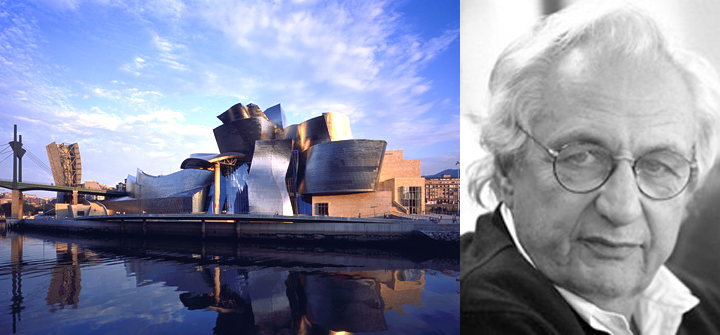
Ieoh Ming Pei
Born 1917
Nationality: Chinese-American
Design aesthetic: I.M.P designs are thoroughly modernist, with significant cubist themes.[146] He is known for combining traditional architectural elements with progressive designs based on simple geometric patterns.
Building types: Bank, offices, Museums, Universities, hotels and embassies
Known for: John F. Kennedy Library,Boston, National Gallery of Art East Building, Louvre Pyramid, Paris, Bank of China Tower, Hong Kong, Museum of Islamic Art, Doha

Santiago Calatrava
Born 1951
Nationality: Spanish
Design aesthetic: Architect, sculptor and structural engineer, Calatrava has been heralded as bridging the division between structural engineering and architecture. In the projects, he continues a tradition of Spanish modernist engineering like that of Antonio Gaudí. Nonetheless, his style is also very personal, and derives from numerous studies of the human body and the natural world.
Building types: Bridges, Art galleries and Museums, Transport buildings, sports complex
Known for: James Joyce and Samuel Beckett bridges, Dublin; Athens Olympic Sports Complex; Auditorio de Tenerife, Canary Islands, Spain; Alamillo bridge, Seville, Andalucia Spain; Chords Bridge, Jerusalem, Israel; Ciutat de les Arts i les Ciències, Valencia, Spain; Liège-Guillemins railway station, Belgium.
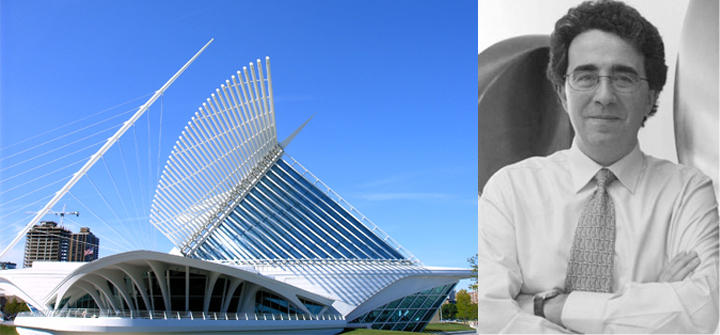
Norman Foster
Born 1935
Nationality: British
Design aesthetic: Foster’s earlier designs reflected a sophisticated, machine-influenced high-tech vision. His style has evolved into a more sharp-edged modernity.
Building types: Offices, Bridges, Museums, renovations/redevelopments, universities and transport buildings
Known for: 30 St Mary Axe, “the gherkin”, London; the Millau Viaduct, France; Hearst Tower, New York City, United States; Wembley Stadium, London; HSBC Main Building, Hong Kong; Reichstag restoration, Berlin, Germany

Zaha Hadid
Born 1950
Nationality: Iraqi-British
Design aesthetic: Architect, interior and product designer, Hadid’s buildings are distinctively futuristic, characterized by the “powerful, curving forms of her elongated structures” with “multiple perspective points and fragmented geometry to evoke the chaos of modern life”.
Building types: Museums, pavilions, offices, cultural centers, interior and product design
Known for: Maxxi, Rome, Italy; Bridge Pavilion, Zaragoza, Spain; Maggie’s Centre, Great Britain; Contemporary Arts Center, Cincinnati, Ohio; BMW Central Building, Leipzig, Germany
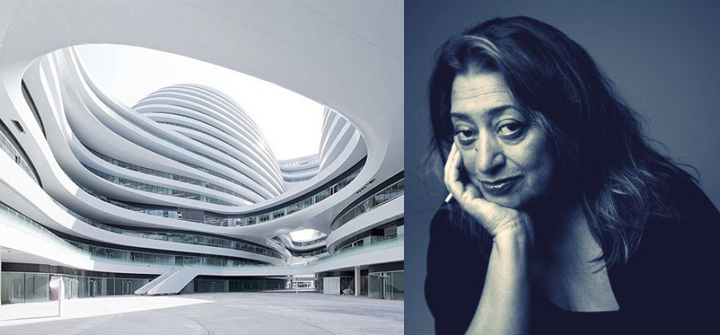
Daniel Libeskind
Born 1946
Nationality: Polish- Jewish
Design aesthetic: Architect, artist, and set designer, critics often describe Libeskind’s work as deconstructivist.
Building types: Museums, theaters, concert halls, convention centers, universities, residences, hotels, and shopping centers
Known for: Denver Art Museum, United States; the Grand Canal Theatre, Dublin; the Imperial War Museum North Greater Manchester, England; the Michael Lee-Chin Crystal at the Royal Ontario Museum, Toronto, Canada; the Felix Nussbaum Haus Osnabrück, Germany; the Danish Jewish Museum Copenhagen, Denmark; the Wohl Centre at the Bar-Ilan University, Ramat-Gan, Israel; World Trade Center site plan, Lower Manhattan
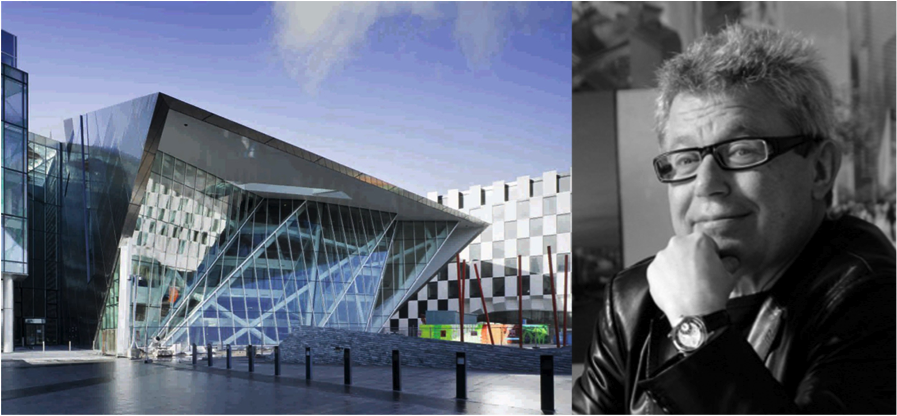
Grafton Architects
Directors: Yvonne Farrell and Shelley McNamara
Practice Established: 1978
Based: Dublin
Design Aesthetic: Grafton Architects designs’ can be described as ‘architecture that is very much about contemporary reality yet nourished by both the distant past and the modern movement’
Building Types: Educational, cultural, housing and exhibitions.
Buildings’ in Ireland: University of Limerick, Limerick; Solstice Arts Centre; Department of Finance, Dublin; Urban Institute of Ireland, Dublin; Loreto Community School, Milford; Ardscoil Mhuire, Ballinasloe; North Kildare Educate Together School, Celbridge.
Buildings’ Abroad: University Luigi Bocconi, Milan, Italy; University campus UTEC, Lima, Peru.
Awards and Exhibition’s: 12th International Venice Biennale, Silver Lion Award, Venice, Italy; Stone Pavillion for Pibamarmi, Verona, Italy.
Website: Grafton Architects

McCulloughMulvin Architects
Directors: Niall McCullogh, Valerie Mulvin & Ruth O’Herlihy
Based: Dublin
Design Aesthetic: McCulloughMulvin’s portfolio of work can be described as ‘an unusual combination of interest in contemporary architecture and old buildings’. The practice ‘retains an interest in the phenomenology of architecture and construction in social and cultural contexts.
Building Types: Educational, libraries, galleries and houses
Buildings: St Brigid’s School, The Coombe, Dublin; Long Room hub, Trinity College Dublin, Dublin; Mardyke Pavillion, University College Cork, Cork; Thurles Arts Centre and Library, Thurles; Rush Library, Rush.
Awards: 2011 RIAI Awards for best Education Building, Trinity Long Room Hub, Dublin; 2011 RIAI Silver Medal, Sligo Court House, Sligo
Website: mcculloughmulvin architects
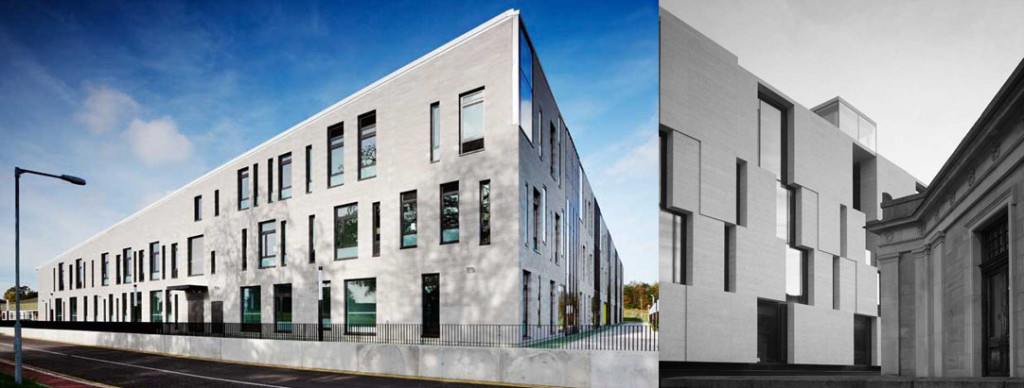
More profiles of architects coming soon!
Architecture is the art or science of the built environment.
Architectural works such as buildings, structures and spaces are often perceived as cultural symbols and as works of art. Historic and contemporary civilizations are often identified with their architectural achievements, such as ancient Egypt and modern New York.
Architecture as an art form is the shaping of space by architects through the use of materials, technology, light and shadow.
Some interesting quotes about architecture…
“Architecture begins with an idea.” Louis Kahn, Architect.
“Architecture is frozen music.” Johann Wolfgang von Goethe, Writer.
“Architecture is to make us know and remember who we are.” Sir Geoffrey Jellicoe, Architect.
“The architect’s role is to fight for a better world, where he can produce an architecture that serves everyone and not just a group of privileged people.” Oscar Niemeyer, Architect.
“Architecture is inhabited sculpture.” Constantin Brancusi, Artist
The internet and library will be key tools during the first stages of your research. Use some of these helpful topics to guide you through this important exercise, making sure to save images (either to your computer, printing or photocopying) and information so that you can present examples of architecture that you like and/or dislike to your group.
Here is a selection of websites, blogs and online magazines to help with your research. Architectural Awards and Festivals taking place all over the world are great ways to gain an insight into Contemporary Architecture, which is often provocative, stimulating and unusual. Archives, such as the Irish Architectural Archive, are also useful sources of information and images on Historic and Modern architecture.
Even more architectural links coming soon. If you have suggestions for informative architectural websites please get in touch and we can add them to our list.
A summary of some of the most well known architectural themes to give you an overview of the development and growth of Architecture through the ages:
Contemporary architecture
Contemporary architecture is, in broad terms, the architecture of the present day. The term contemporary architecture is also applied to a range of styles of recently built structures and spaces.
Modern architecture
Early modern architecture began at the turn of the 20th century with efforts to reconcile the principles underlying architectural design with rapid technological advancement and the modernization of society. It is generally characterized by the simplification of form and lack of decorative ornamentation. Instead, the style of the buildings is strongly influenced by the structure. Modern Architecture is a very broad term and includes numerous movements, schools of design, and architectural styles, including Bauhaus, the International Style and Brutalism.
Notable architects important to the history and development of the modernist movement include Frank Lloyd Wright, Ludwig Mies van der Rohe, Walter Gropius, Le Corbusier, Louis Sullivan, Oscar Niemeyer and Alvar Aalto.
Postmodern architecture
Postmodernity in architecture can be described as the return of “wit, ornament and reference” to architecture in response to the formalism of the International Style of modernism. The first examples of this style are generally cited as being from the 1950’s, but it did not become a movement until the late 1970’s. As with many cultural movements, some of Postmodernism’s most pronounced and visible ideas can be seen in architecture. The functional and formalized shapes and spaces of the modernist style are replaced by diverse aesthetics: styles collide, form is adopted for its own sake, and new ways of viewing familiar styles and space abound. Perhaps most obviously, architects rediscovered the expressive and symbolic value of architectural elements and forms that had evolved through centuries of building, which had been abandoned by the modern style.
Sustainable/Green architecture
Sustainable architecture is a general term that describes environmentally conscious design techniques in the field of architecture. Sustainable architecture is framed by the larger discussion of sustainability and the pressing economic and political issues of our world. In the broad context, sustainable architecture seeks to minimize the negative environmental impact of buildings by enhancing efficiency and moderation in the use of materials, energy and space. The idea of sustainability, or ecological design, is to ensure that our actions and decisions today do not harm future generations. The term can be used to describe an energy and ecologically conscious approach to the design of the built environment.
Energy efficiency over the entire life cycle of a building is the single most important goal of sustainable architecture. Architects use many different techniques to reduce the energy needs of buildings and increase their ability to capture or generate their own energy.
Hi-Tech architecture
High-tech architecture, also known as Late Modernism or Structural Expressionism, is an architectural style that emerged in the 1970s, incorporating elements of high-tech industry and technology into building design.
Low-Tech architecture
In an attempt to reverse this trend, advocates of Low Tech, a new ecological approach to architecture, propose that we take a new look at construction techniques used in the past to ensure that the architecture of the future addresses ethical concerns as well as maintaining the current level of efficiency.
Click on the images above to read more about the projects!
These profiles are just a brief sample of some of the most well-known and highly respected architects of today and of recent times.
This selection of pioneers and visionaries can help you to gain an overview of key figures and diverse styles in Architecture.
Use these profiles to help with your online research.
Frank Lloyd Wright
1867 – 1959
Nationality: American
Design aesthetic: Architect, interior designer, writer and educator, Wright designed structures which were in harmony with humanity and its environment, a philosophy he called organic architecture.
Building types: Offices, churches, schools, skyscrapers, hotels, and museums and building interiors.
Known for: Robie House, Price Tower, Fallingwater, Johnson Wax Headquarters, Solomon R. Guggenheim Museum, Taliesin and Darwin D. Martin House
Sophia Hayden Bennett
1868-1953
Born 17 October 1868, South America
Sophia Hayden Bennett was the first woman admitted to the MIT architecture programme in 1886. She went on to become the first woman to receive a degree in architecture from the Institute, graduating with honours in 1890.
Upon graduating, Hayden Bennett entered a design competition as part of the World’s Columbian Exposition of 1893 in Chicago. Her design for the Woman’s Building, in the style of the Italian Renaissance, won the competition. The concept of the building was unusual for its time as all aspects of the building were planned by women.
Known for: The Woman’s Building, Los Angeles, California
Marion Mahony Griffin
1871-1962
Nationality: American
Marion Mahony Griffin graduated from the MIT architecture programme in 1894. She went to work for Frank Lloyd Wright in 1895 and would continue to work with him for fourteen years. Mahony Griffin became one of Wright’s primary designers and was responsible for many of the furnishings of his houses. She contributed as a designer to the development of the Prairie School which revolutionised American architecture.
Mahony Griffin worked mainly as an architectural renderer and she developed her distinctive rendering style while working for Wright.
Design aesthetic: She developed a distinctive rendering style that was influenced in both composition and technique by Japanese prints. Her drawings were instrumental in enhancing Wright’s early reputation and she became indispensable as a talented delineator.
“She was the greatest architectural delineator of her generation, which included mere men like Lutyens, Loos and Wright.” Reyner Banham, Architectural Review Death and Life of the Prairie School (1973)
Julia Morgan
1872-1957
Nationality: American
Born in 1872 Oakland, California
On Dec. 12 2014 the AIA Gold Medal was posthumously awarded to Julia Morgan, FAIA, the early 20th-century architect. Her huge output of quality work secured her position as the first great female American architect and the first woman to ever be given the AIA Gold Medal. By receiving the award, Morgan was elevated to the College of Fellows. The Gold Medal is the highest honour the American Institute of Architects confers on an architect and it acknowledges an individual whose significant body of work has had a lasting influence on the theory and practice of architecture.
Julia Morgan studied civil engineering at the University of California, Berkeley and then completed the architecture programme in 1902 at the École des Beaux-Arts, the most prominent architecture school of its day. In 1904, she became the first women licensed to practice architecture in California and opened her own firm. She joined the AIA in 1921 as only the seventh female member.
She employed an array of architectural styles: Tudor and Georgian houses, Romanesque Revival churches, and Spanish Colonial country estates with an Islamic tinge, gathering motifs and methods from Western architectural history in order to select the approach most appropriate for each unique site and context.
Known for: St. John’s Presbyterian Church in Berkeley, Asilomar YWCA in Pacific Grove, California and Hearst Castle in San Simeon, California.
Eileen Gray
1878 – 1976
Nationality: Irish
Design aesthetic: Architect, interior and furniture designer, Grey pursued the alliance of form and function in an expressive modern spirit.
Building types: Architecture, Furniture and Interior Design
Known for: E-1027, (a unique house in South of France)The ‘Tempe à Pailla’ House, the Bibendum Chair and her lacquer work
Walter Gropius
1883 – 1969
Nationality: German/American
Design aesthetic: Architect, author and educator had a functionalist approach to design.
Building types: Office, factory, residential homes, hospital, college faulty, school, large-scale housing projects.
Known for: Fagus Factory, Werkbund Exhibition (1914), Bauhaus, Gropius House, University of Baghdad, J.F. Kennedy Federal Building and Pan Am Building
Lilly Reich
1885-1947
Nationality: German
Lilly Reich was a German modernist designer and a close collaborator with Ludwig Mies Van der Rohe for more than ten years. She apprenticed as an industrial embroiderer and in 1908 Reich came to work for the Wiener Werkstätte. In 1912 she joined the Deutscher Werkbund, becoming the first female member of its board of directors in 1920. Reich designed a sample flat in Berlin for a working-class family in 1912. Her flat was widely praised for the clarity and functionalism of the furnishings.
After the war, and from 1924 until 1926, she was employed at the Messeamt in Frankfurt, where she was responsible for trade fair design. Here she met Mies van der Rohe and became an employee of his practice. They collaborated as artistic directors in 1927 on organizing the Werkbund exhibition in Stuttgart.
In 1929 Reich and Mies van der Rohe were appointed to organise the German contribution to the World Exposition in Barcelona. In 1932 Reich was appointed as director of the building department and the weaving workshop at the Bauhaus Dessau. After the Second World War, Reich taught interior design and building theory at Berlin University of the Arts, while continuing to run a studio for architecture, design, textiles and fashion in Berlin.
Known for: Villa Tugendhat, Brno, Czechoslovakia
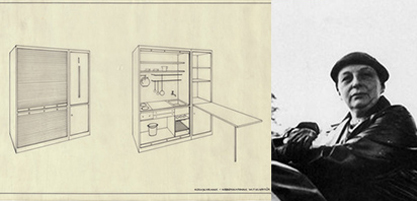
Lilly Reich and Single-Person Apartment in The Dwelling of Our Time, German Building Exhibition (1931)
Ludwig Mies van der Rohe
1886 – 1969
Nationality: German-American
Design aesthetic: Architect and educator, Mies van der Rohe developed and built his vision of a monumental “skin and bones” architecture that reflected his goal to provide the individual a place to fulfill himself in the modern era. Mies sought to create free and open spaces, enclosed within a structural order with minimal presence.
Building types: Residential apartment complexes, residential homes, offices, university complexes and pavilions.
Known for: Barcelona Pavilion, Tugendhat House, Crown Hall, Farnsworth House, 860–880 Lake Shore Drive, Seagram Building, New National Gallery, Berlin, Toronto-Dominion Centre,
Westmount Square
Le Corbusier
1887 –1965
Nationality: Swiss/French
Design aesthetic: Architect, designer, urbanist, and writer, Corbusier’s designs were modern high design and were dedicated to providing better living conditions for the residents of crowded cities.
Building types: Residential Complexes, Museums, Pavilions, residential homes, church
Known for: Villa Savoye, France; Notre Dame du Haut, France; Buildings in Chandigarh, India
Charlotte Perriand
1903-1999
Nationality: French
Born October 1903, Paris
In 1920 Charlotte Perriand enrolled as a student at the Ecole de l’Union Centrale des Arts Décoratifs, and would study there for a further five years. Here she found inspiration in the machine aesthetic of the motor cars and bicycles she saw on the Paris streets.
It was Charlotte Perriand’s Bar sous le Toît, or rooftop bar, created in glass, steel and aluminium for the Salon D’Automne exhibition in Paris, that impressed Le Corbusier enough to invite her to join his studio in 1927. Together with Le Corbusier and Pierre Jeanneret, Perriand developed a series of tubular steel chairs, which are still today hailed as icons of the machine age. Perriand remained at Le Corbusier’s studio for over a decade and she was an influential figure in the modern movement.
Design aesthetic: Perriand introduced the ‘machine age’ aesthetic to interiors in the steel, aluminium and glass furniture she created in the late 1920s and 1930s.
Known for: Méribel ski resort, France, The League of Nations building, Geneva
Oscar Niemeyer
1907 – 2012
Nationality: Brazilian
Design aesthetic: Architect who is considered to be one of the key figures in the development of modern architecture.
Building types: Hospital, College, Headquarters, residential homes, town planning and landscaping
Known for: Palácio da Alvorada, Cathedral of Brasília, National Congress of Brazil, Edifício Copan, Ibirapuera Park, United Nations headquarters, Niterói Contemporary Art Museum, Latin America Memorial and Gustavo Capanema Palace
Jane Drew
1911-1996
Nationality: British
Born 24 March 1911, Surrey
Jane Drew was an English modernist architect, educator and town planner who worked in the United Kingdom as well as Africa and India. Drew was one of the principal founders of the Modern Movement in Britain. She was a graduate of the Architectural Association School, London, a member of the Modern Architectural Research Group and from 1941–43 Drew executed specialist studies on kitchen planning for the British Commercial Gas Corporation.
Design aesthetic: Drew based her work on the principle that architecture should provide a space in which human beings can flourish, both physically and spiritually.
Drew met her husband Maxwell Fry, through the Modern Architectural Research Group. Together they were forerunners in the field of modern tropical building and town planning. From 1944 to 1946 Drew was assistant town-planning adviser to the resident minister for the British West African colonies. In 1946 Drew and Fry formed the firm of Fry, Drew and Partners in London, concentrating on large-scale planning for tropical countries. The University of Ibadan (1953–59), Nigeria, is one of the many tropical buildings they designed.
Known for: University of Ibadan, Nigeria
Ieoh Ming Pei
Born 1917
Nationality: Chinese-American
Design aesthetic: I.M.P designs are thoroughly modernist, with significant cubist themes.[146] He is known for combining traditional architectural elements with progressive designs based on simple geometric patterns.
Building types: Bank, offices, Museums, Universities, hotels and embassies
Known for: John F. Kennedy Library,Boston, National Gallery of Art East Building, Louvre Pyramid, Paris, Bank of China Tower, Hong Kong, Museum of Islamic Art, Doha
Anne Tyng
1920-2011
Born 14 July 1920, China
Anne Griswold Tyng devoted her career to achieving a synthesis of geometric order and human consciousness within architecture. Tyng moved to the U.S. in 1938 to study fine arts at Radcliffe College. During her final year she would come to study architecture through the Cambridge School of Architecture and Landscape Architecture program. Following this, Tyng studied architecture at Harvard Graduate School of Design (GSD) under Walter Gropius, Joseph Hudnut and Marcel Breuer. Tyng was among the first group of women admitted to the GSD.
The Bauhaus-inspired training she received at Harvard equipped her with a dedication to low-cost housing and to the purer forms of the international style. Tyng worked in the New York offices of architect Konrad Wachsmann (1944), the industrial design firms of Van Doren, Nowland and Schladermundt (1944) and at Knoll Associates (1944-45). She began working in the office of Stonorov and Kahn in 1945.
Design aesthetic: Tyng’s search for the essence of constructive geometry guided her independent design work. She characterized each stage of her life as an evolution of “psychological development necessary to free her creative potential” enabling her to become heroine of her own ideas rather than a muse to the creative potential of another.
In 1965, she was one of the first women to receive a fellowship from the Graham Foundation Advanced Studies in the Fine Arts for her project Anatomy of Form: The Divine Proportion in the Platonic Solids (1964).
Tyng was one of only three women from the United States selected to participate in the First International Congress of Women Architects in 1976. She was made a Fellow of the American Institute of Architects and an academician of the National Academy of Design in 1975.
Norma Merrick Sklarek
1928-2012
Born 15 April 1928, New York</p)
Nationality: American
Norma Sklarek was the first licensed African-American female architect in the United States. She broke further boundaries by becoming the first African-American female inducted as a fellow in the American Institute of Architects.
From a young age Merrick Sklarek ‘s love of architecture was rooted in her passion for art, the sciences and math. She enrolled at Columbia University’s School of Architecture and graduated the first licensed African-American female architect. She began working for Skidmore, Owings and Merrill in New York and then at Gruen Associates in Los Angeles, where she was named the firm’s director in 1966. Later, as vice president of the Welton Becket firm, she left her mark on several important projects including the American Embassy in Tokyo, the 2.5 million square foot fashion center California Mart, the Fox Plaza in San Francisco and Terminal One at Los Angeles International Airport.
In 1985, Sklarek made history again when she became the first African-American woman to establish and manage the female-owned architectural firm Siegel, Sklarek and Diamond. In addition to teaching several graduate courses at colleges such as UCLA, Columbia and Arizona State University, she served on the California Architects Board. Sklarek authored several articles and chaired the AIA National Ethics Council. Howard University has an architecture scholarship in her name.
In 2008 Sklarek was honored with the Whitney Young Jr. Award, an honour granted annually to an architect who best exemplifies “the profession’s responsibility toward current social issues.”
Known for: San Bernardino City Hall, San Bernardino, California, Fox Plaza in San Francisco, Terminal One, Los Angeles International Airport and the Embassy of the United States in Tokyo, Japan.
Frank Gehry
Born 1929
Nationality: Canadian-American
Design aesthetic: Architect, Furniture, household, jewelry designer and educator, Gehrys work falls within the style of Deconstructivism.
Building types: Furniture, household and jewelry designs, museums, residential homes, housing complexes and sculptures
Known for: Guggenheim Museum, Bilbao, Spain; MIT Ray and Maria Stata Center, Cambridge, Massachusetts; Walt Disney Concert Hall, Los Angeles; Experience Music Project, Seattle; Weisman Art Museum, Minneapolis; Dancing House, Prague; the Vitra Design Museum and MARTa Museum, Germany; the Art Gallery of Ontario, Toronto; the Cinémathèque Française, Paris; and 8 Spruce Street, New York City.
Norman Foster
Born 1935
Nationality: British
Design aesthetic: Foster’s earlier designs reflected a sophisticated, machine-influenced high-tech vision. His style has evolved into a more sharp-edged modernity.
Building types: Offices, Bridges, Museums, renovations/redevelopments, universities and transport buildings
Known for: 30 St Mary Axe, “the gherkin”, London; the Millau Viaduct, France; Hearst Tower, New York City, United States; Wembley Stadium, London; HSBC Main Building, Hong Kong; Reichstag restoration, Berlin, Germany
Renzo Piano
born 1937
Nationality: Italian
Design aesthetic: Architecture critic Nicolai Ouroussoff said of Piano’s works that the “…serenity of his best buildings can almost make you believe that we live in a civilized world.”
Building types: Museums, offices, bridges, and transport buildings
Known for: Centre Georges Pompidou, Parco della Musica, Shard London Bridge, The Living Roof of the California Academy of Sciences, The Art Institute of Chicago
Daniel Libeskind
Born 1946
Nationality: Polish- Jewish
Design aesthetic: Architect, artist, and set designer, critics often describe Libeskind’s work as deconstructivist.
Building types: Museums, theaters, concert halls, convention centers, universities, residences, hotels, and shopping centers
Known for: Denver Art Museum, United States; the Grand Canal Theatre, Dublin; the Imperial War Museum North Greater Manchester, England; the Michael Lee-Chin Crystal at the Royal Ontario Museum, Toronto, Canada; the Felix Nussbaum Haus Osnabrück, Germany; the Danish Jewish Museum Copenhagen, Denmark; the Wohl Centre at the Bar-Ilan University, Ramat-Gan, Israel; World Trade Center site plan, Lower Manhattan
Zaha Hadid
Born 1950
Nationality: Iraqi-British
Design aesthetic: Architect, interior and product designer, Hadid’s buildings are distinctively futuristic, characterized by the “powerful, curving forms of her elongated structures” with “multiple perspective points and fragmented geometry to evoke the chaos of modern life”.
Building types: Museums, pavilions, offices, cultural centers, interior and product design
Known for: Maxxi, Rome, Italy; Bridge Pavilion, Zaragoza, Spain; Maggie’s Centre, Great Britain; Contemporary Arts Center, Cincinnati, Ohio; BMW Central Building, Leipzig, Germany
Santiago Calatrava
Born 1951
Nationality: Spanish
Design aesthetic: Architect, sculptor and structural engineer, Calatrava has been heralded as bridging the division between structural engineering and architecture. In the projects, he continues a tradition of Spanish modernist engineering like that of Antonio Gaudí. Nonetheless, his style is also very personal, and derives from numerous studies of the human body and the natural world.
Building types: Bridges, Art galleries and Museums, Transport buildings, sports complex
Known for: James Joyce and Samuel Beckett bridges, Dublin; Athens Olympic Sports Complex; Auditorio de Tenerife, Canary Islands, Spain; Alamillo bridge, Seville, Andalucia Spain; Chords Bridge, Jerusalem, Israel; Ciutat de les Arts i les Ciències, Valencia, Spain; Liège-Guillemins railway station, Belgium.
Grafton Architects
Directors: Yvonne Farrell and Shelley McNamara
Practice Established: 1978
Based: Dublin
Design Aesthetic: Grafton Architects designs’ can be described as ‘architecture that is very much about contemporary reality yet nourished by both the distant past and the modern movement’
Building Types: Educational, cultural, housing and exhibitions.
Buildings’ in Ireland: University of Limerick, Limerick; Solstice Arts Centre; Department of Finance, Dublin; Urban Institute of Ireland, Dublin; Loreto Community School, Milford; Ardscoil Mhuire, Ballinasloe; North Kildare Educate Together School, Celbridge.
Buildings’ Abroad: University Luigi Bocconi, Milan, Italy; University campus UTEC, Lima, Peru.
Awards and Exhibition’s: 12th International Venice Biennale, Silver Lion Award, Venice, Italy; Stone Pavillion for Pibamarmi, Verona, Italy.
Website: Grafton Architects
McCulloughMulvin Architects
Directors: Niall McCullogh, Valerie Mulvin & Ruth O’Herlihy
Based: Dublin
Design Aesthetic: McCulloughMulvin’s portfolio of work can be described as ‘an unusual combination of interest in contemporary architecture and old buildings’. The practice ‘retains an interest in the phenomenology of architecture and construction in social and cultural contexts.
Building Types: Educational, libraries, galleries and houses
Buildings: St Brigid’s School, The Coombe, Dublin; Long Room hub, Trinity College Dublin, Dublin; Mardyke Pavillion, University College Cork, Cork; Thurles Arts Centre and Library, Thurles; Rush Library, Rush.
Awards: 2011 RIAI Awards for best Education Building, Trinity Long Room Hub, Dublin; 2011 RIAI Silver Medal, Sligo Court House, Sligo
Website: mcculloughmulvin architects
O’Donnell + Tuomey Architects
Directors: John Tuomey and Sheila O’Donnell
Based: Dublin
John Tuomey and Sheila O’Donnell met while studying architecture in university and worked together since then as O’Donnell + Tuomey for more than 25 years. In 2015 they received the Royal Gold Medal from the Royal Institute of British Architects (RIBA), the world’s most prestigious award in architecture. The RIBA Royal Gold Medal is awarded in recognition of a lifetime’s work and is awarded to people who have had a significant influence “either directly or indirectly on the advancement of architecture”.
The husband and wife team co-founded their practice in Dublin in 1988. In the early 1990s, O’Donnell and Tuomey were part of the ‘Group 91 Architects’ group whose collective skill in master planning spearheaded the regeneration of Dublin’s neglected Temple Bar. The Irish Film Institute (1991) was the first permanent building that brought profile and acclaim to the pair, for its dynamic contribution to the revitalised Dublin quarter.
Their early work, ranging from a private home in Navan to schools, public housing and community buildings, provided the canvas for them to experiment and evolve their unconventional creative approach.
Awards: O’Donnell + Tuomey have been shortlisted for the RIBA Stirling Prize five times and have exhibited three times at the Venice Architecture Biennale. O’Donnell + Tuomey have won the AAI Downes Medal for Excellence in Architectural Design seven times and in 2005 were awarded the RIAI Gold Medal, the highest award in Irish Architecture. RIBA described Sheila O’Donnell and John Tuomey as “a tour de force in contemporary Irish and British architecture.”
Building types: Community, Culture, Education, Housing, Houses
Buildings: The Photographers’ Gallery in Soho, the 2014 RIBA Stirling Prize-shortlisted Saw Swee Hock Student Centre at the London School of Economics, the Irish Language Cultural Centre, Derry, Northern Ireland.
Website: O’Donnell + Tuomey architects
More profiles of architects coming soon!
